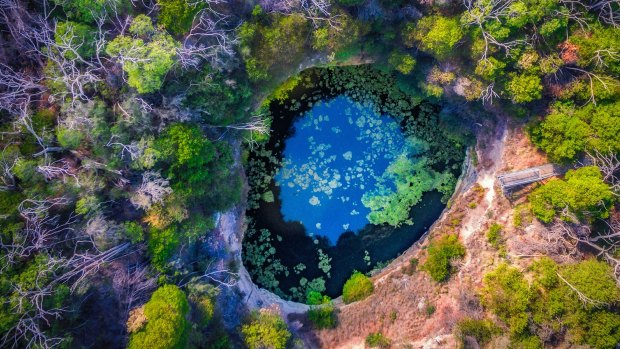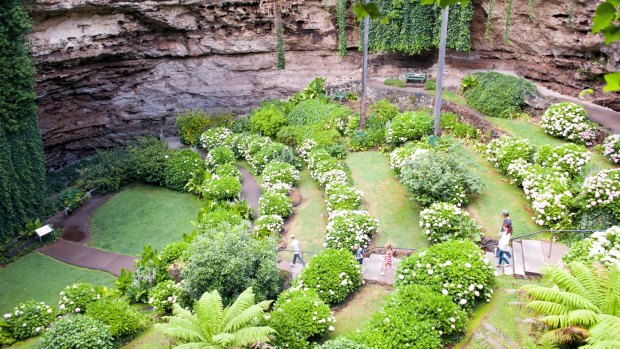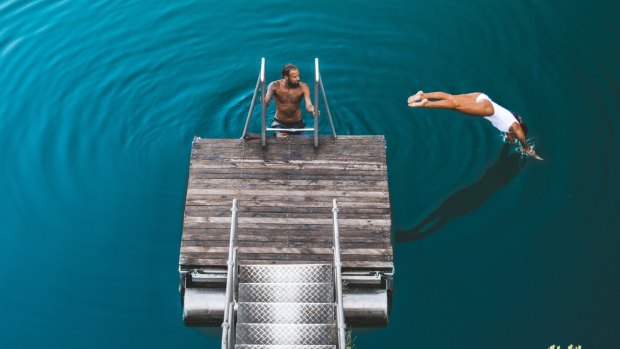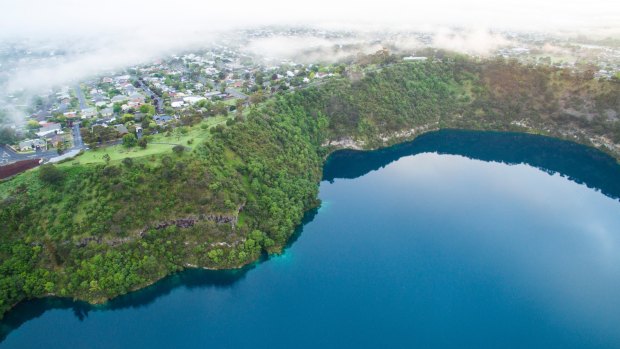This was published 4 years ago
Limestone Coast, South Australia: Six magical sinkholes, sunken gardens and 'hellmouths' you must visit
By Kylie McLaughlin
Halfway between Melbourne and Adelaide, South Australia's Limestone Coast holds a cornucopia of delights, hidden below the Earth's surface. Lava that erupted from volcanoes thousands of years ago formed a Swiss cheese network of 800 caves. Over time, some of the roofs of these caves have collapsed, exposing the secret existence of 50 sinkholes in the region. Here's some you should visit.
Hells Hole

Credit: Michael Waterhouse/SATC
About 20 kilometres from anywhere resembling a town in the south-east, a inconspicuous dirt road cuts through man-made forest to the most ominously-named sinkhole of them all. Despite the popularity of other surrounding cenotes, there's not a single person to be seen on the road, or at the park from which a pathway leads to a shaggy and distinctly out-of-place patch of bush. It's eerily quiet when I reach the hellmouth, which has been made accessible to visitors by an enclosed steel bridge which juts over the top of the sinkhole, the height from which makes me instantly woozy. I clutch my new iPhone a little tighter, brave a few quick shots, and then scuttle back to the safety of my car, just in time to see an entourage of visitors arrive. Hells Hole is 45 metres in diameter, 25 metres deep and it's 38 metres to the water from the viewing platform. It's a popular site for diving, and permits can be obtained through ForestrySA. The similarly accessible Caroline Sinkhole is a short drive away in Penambol Conservation Park. Sea Coast Hill Road, Caveton
Umpherston Sinkhole

Credit: Mike Haines/SATC
Scottish settler, farmer and politician James Umpherston purchased the property called "The Caves" in 1868, planting the seeds to create what is now known as the magical sunken garden. It's clear that Unpherston can no longer be considered much of a "hidden" gem, given the expansive adjoining car park and cafe and the huge numbers of people swarming through its gardens in the middle of the day during the Christmas holidays. It's not the only thing swarming, however; bees are a feature of the gardens, but don't blame them for the constant buzzing noise that echoes around this old cenote. That's the sound of a dozen drones, whose owners are all vying to outdo each other on social media platforms. However the best snaps are actually taken from the bottom of the sinkhole, capturing its huge circumference and beautiful curtain-like hanging vines. Twenty metres deep and 50 metres across, the paradisaical hole is in stark contrast to the hellmouth above; outside of school holidays it would be a very pleasant place to picnic. Jubilee Hwy E, Mount Gambier
Cave Garden
A poorer cousin of Umpherston, but conveniently located in central Mount Gambier is the Cave Garden, a 27 metre hole in the ground filled with water that used to be the town's water supply. Again it was ably decorated during the 1890s with shady trees and chairs, but the end result is more of a rough-and tumble overgrown garden, with a pathway and viewing platforms leading halfway down to the bottom. File under "since we're here, we may as well". It may be more interesting during the winter months when water flows into the cenote. 1 Bay Road, Mount Gambier
The Little Blue Lake

Credit: Luke Riddle/SATC
With age estimates ranging between 15,000 to 100,000 years, the Little Blue Lake could outdate the larger Blue Lake by up to 95,000 years. Around 10 minutes' drive south of Mount Gambier, the Little Blue Lake feels more like a huge deep swimming pool in the middle of a gumtree-studded paddock than any kind of former cave. Recently embellished with stairs that lead down to the water and a floating pontoon, this is a fun spot to camp out for a day of swimming (although be warned, there are no facilities). The stairs and the pontoon do not deter the kids from jumping off the side of the sinkhole's sheer 8-metre tall walls into the waters below - neither do the signs forbidding it. The lake is located between Mount Schank and Mount Gambier, two dormant volcanoes. As the name suggests, it does turn blue on a regular basis, but don't be disappointed to find it green - its standard colour. The maximum depth is around 47 metres. Nearby Kilsby Sinkhole (on private property) can be dived or viewed if you book ahead. Protip: they produce gin from the sinkhole's waters. Mount Salt Road, Mount Schank
Blue Lake

Credit: Ockert Le Roux/SATC
The granddaddy of them all, the Blue Lake and the adjoining emerald-coloured Valley Lake are worth a visit, even if it's just a drive by. But if you're spending some time in Mt Gambier, or using it as a base, the Blue Lake has a 3.6 kilometre walking track around its circumference (which you can also drive). The lake is an extinct volcano whose waters changes shades of blue depending on the season. For those of us missing regular trips to the US, the lake is the closest thing you'll get to Oregon's Crater Lake - and a damn site smaller (the Oregon version is 8 kilometres in diameter and a 53 kilometre drive around the rim!). Protip: Adjacent Valley Lake - another crater lake - is the hidden gem here, a lush and quiet spot with picnic grounds, a wildlife sanctuary and walking trails.
Naracoorte Caves
You can't mention the sinkholes of Mount Gambier without talking about the World Heritage Listed, 800,000 year old Limestone Coast caves. Of the 28 caves that are in the national park, only four are open to the public, with the rest reserved for scientific research. Guided tours give a 30 minute snapshot of history and science and spotlight some of the caves' most magnificent stalactites and stalagmites. We see a couple of bones from a flat-faced leaf-eating kangaroo - a two metre high, 200kg creature misfortunate enough to fall into the cave 15,000 years ago, unwittingly donating its life to science. Still, that makes it positively youthful compared to some of the fossils dating back to half a million years that are also found here. For information on visiting, see www.naracoortecaves.sa.gov.au
The writer was a guest of SATC
Sign up for the Traveller Deals newsletter
Get exclusive travel deals delivered straight to your inbox. Sign up now.